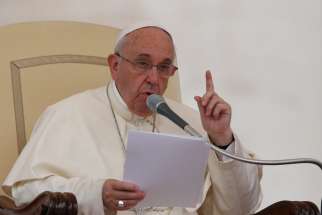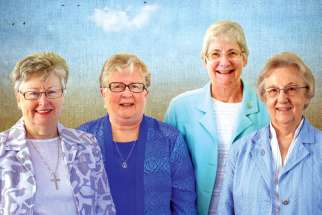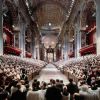Fifth Sunday of Lent, April 7 (Year C) Isaiah 43:16-21; Psalm 126; Philippians 3:8-14; John 8:1-11
The motto of God could well be “I am about to do a new thing!”
Doctrine, pastoral realities are not at odds, pope tells theologians
VATICAN CITY - The church is called to embrace its past, present and future and to avoid the temptations to condemn or to legitimize everything just because it is new and different, Pope Francis told a group of theologians.
Sisters to leave legacy with Providence Village
The Sisters of Providence of St. Vincent de Paul are striking out on a bold new future that is rooted in a proud past.
The Church’s past weaved into the future
The Second Vatican Council might be easier to understand if it had been called Back To The Future.
The two central ideas of the council appear to be headed in opposite directions. The first goes by a French title, resourcement, the second by an Italian one, aggiornamento.
Resourcement was a movement back in time. For half a century before the 1962-1965 council, theologians and many ordinary Catholics had been calling the Church back to its roots in Scripture, the early Church and even the Judaism of Jesus and His apostles. The Latin war cry on behalf of resourcement at the council was “Ad fontes!” (“To the sources!”), and one of its greatest advocates was Fr. Joseph Ratzinger. He would go on to interpret the council as a theologian, bishop, cardinal, prefect of the Congregation for the Doctrine of the Faith and now as Pope Benedict XVI.
Aggiornamento looked forward. It was how Pope John XXIII explained the basic impulse of the council. He wanted to open up the doors and windows of the Church and welcome in the world, to greet the modern age and all its cultural and technological revolutions with something more than suspicion, fear and rejection. The word means “up to the moment” in the sense of renewal.
Fifty years ago, the job of 2,860 bishops, with help from almost every significant theologian then living, was to weave the past and the future — resourcement and aggiornamento — into a seamless garment. As hard as the Church has worked to pull together those two impulses, other Catholics, conservative and liberal, have tried to pull them apart — or make one end of the spectrum more important than the other.
Liberal theologian Gregory Baum, who worked for Cardinal Augustin Bea at the Council, isn’t surprised that people want to downplay aggiornamento and all that it brought.
“There are people for whom religion means security. The world changes, everything changes, nothing is reliable,” Baum told The Catholic Register. “But the one thing that’s reliable and is unchanging is the religion they have inherited — not God, but the religion we have inherited.”
Change even small parts of their religion and you threaten people’s security, Baum said.
“It is a frightening thing,” he said.
Since the 1970s Fr. Alphonse de Valk, a conservative writer and founder of Catholic Insight magazine, has objected to the idea that the council could change the Catholic Church.
“I always supported the council,” de Valk said. “What I have attacked of course is the spirit of the council in which people said all sorts of silly things that were never discussed in the council... The ones I have opposed for these 50 years were the ones who said that the Vatican Council was a whole new beginning for the Catholic Church, and that this was something radically new, and we could forget everything we had ever been taught.”
Controversy over the council often obscures its historical context. It convened less than 20 years after the Second World War, in the shadow of the Cuban Missile Crisis, in the middle of the Cold War. At the same time, the council needs to be understood in the light of contemporary challenges to the Church, said Saint Paul University theologian and ecumenist Cathy Clifford.
“It’s probably more challenging today, even 50 years after Vatican II, because the Church is twice the size it was 50 years ago and now two-thirds of Catholics are in the southern hemisphere and non- European cultures,” she said.
From an African perspective, the Second Vatican Council was in a slightly different context. It came at the end of the colonial era, when more than 50 new nations were being born on that one continent.
“It has now become global. It’s the Church of the whole world,” Cardinal Peter Turkson told The Catholic Register. “We had a true representation of the world Church.”
For two generations after the council the African Church grew. Missionaries were replaced by local, African clergy. The continent went from 15,000 priests in 1962 to 40,000 in 2012. New dioceses with new bishops came into existence. The Novus Ordo Mass really is a new world order in Africa, with women and children dancing up the aisle to present the gifts and music that soars and thrills in natural three-part harmony pushed ahead by drums.
At the council the hierarchy of the Western Church — from the pope down through to deacons — invited the interaction of lay people. Just 24 years old in 1962, while studying theology at Toronto’s University of St. Michael’s College, Janet Somerville took up the invitation with joy and gusto. She witnessed the transformation from the days when people prayed rosaries while the Sunday readings poured off the ambo in Latin. Not just her mind, but her heart was opened by a sophisticated, scientific reading of the Bible rooted in history. At the same time, Catholics and Protestants were suddenly talking together about their faith.
“To me it felt as if the Catholic Church was renewing and reaffirming its rootedness in Scripture just in time to welcome much
more warmly the gifts of the Spirit that were flourishing in the Churches of the Protestant Reformation,” said Somerville. “I just rejoiced at that.”
She also rejoiced that a pope could cry “No More War” in an address to the entire world, as Pope John XXIII did in his encyclical Pacem in Terris. When the Vatican Council defined the Church in response to “The joy and hope, the grief and anguish of men of our time” in Gaudium et Spes, she knew it was just right.
Fifty years later it’s still just right, but bears reading again, she said. All that joy and optimism made it harder to see the full picture.
After a lifetime of work in religious journalism, a career as a CBC producer and as the first Catholic general secretary to the Canadian Council of Churches, Somerville has come to appreciate a little the conservative caution about Vatican II.
“Do I think we need more Catholic identity? Yes, I do,” she said. “But not because the Second Vatican Council wasn’t saying the things we need to know and the things we need to hear. It was. And not because we need to re-inculcate such a fear of the world and such a suspicion of the world that (the world’s) noble side and its great aspirations are as taboo in our homes as sexy advertising and consumerism and greed and living for the moment.”
There’s no shortage of people who wanted more out of the Second Vatican Council — more collegiality, more openness, more change, less centralization.
“By and large, certainly (the council) has been dealt some very serious blows,” said Jesuit Church historian John O’Malley.
But turning the counci l into a cultural battleground doesn’t advance the cause, said Clifford.
“I don’t know if disappointment is the kind of response that is helpful,” she said. “It is important to recognize that we haven’t fully received what the council taught. We haven’t fully implemented many of the structures that were provided for, even in the revision of the Code of Canon Law that followed the council. In some ways, we’ve received the council in a minimalist way.”
Hope is the response that Pope Benedict XVI has tried to foster.
“Many people have given up the fight. Many people have just lost interest, which is even worse,” said Somerville. “Pope Benedict XVI has a very interesting balance in the way he never rejects the council but does not put any short timelines on any of the victories we were confidently expecting.”
Hope was how it all started.
In 1959 Pope John XXIII first discussed with a few of his cardinals just what he had in mind. He told them: “I am thinking of the care of the souls of the faithful in these modern times... I am saddened when people forget the place of God in their lives and pursue earthly goods as though they were an end in themselves. I think, in fact, that this blind pursuit of the things of this world emerges from the power of darkness, not from the light of the Gospels, and it is enabled by modern technology. All of this weakens the energy of the spirit and generally leads to divisions, spiritual decline and moral failure. As a priest, and now as shepherd of the Church, I am troubled and aroused by this tendency in modern life and this makes me determined to recall certain ancient practices of the Church in order to stem the tide of this decline. Throughout the history of the Church, such renewal has always yielded wonderful results.”
The good pope was not speaking as a theologian, but as a pastor. A year into his own papacy, Pope Benedict gave a name to Pope John’s hopeful, pastoral impulse. He called it the “hermeneutic of reform.”
“With the Second Vatican Council the time came when broad new thinking was required. It’s content was certainly only roughly traced in the conciliar texts, but this determined its essential direction so that the dialogue between reason and faith, particularly important today, found its bearings on the basis of the Second Vatican Council,” he said.
Hermeneutic is a technical term in philosophy meaning a method of interpretation. Benedict famously contrasted interpretations of the Council based on reform with interpretations based on “discontinuity and rupture.” It is wrong to imagine the Church somehow started again in 1962, or that the Church before the Council was a different Church. There is only one mystical body of Christ, and it is the same through all time.





